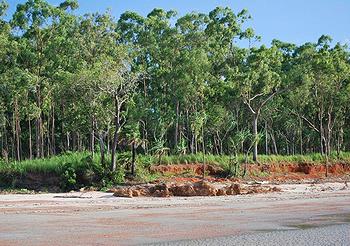
CANBERRA, Australia, May 22, 2013 (ENS) – Australian Environment Minister Tony Burke has approved Rio Tinto Alcan’s new South of Embley bauxite mine on Cape York, the Queensland peninsula that the Australian government intends to propose as a UNESCO World Heritage site.
Announcing the approval May 15, Burke said with the 76 strict conditions he has placed on the development, he is satisfied that the bauxite mine and port project in western Cape York “can go ahead without unacceptable impacts on the environment.”

“My decision comes after a rigorous environmental assessment, and the conditions I have placed on the project will ensure that the region is protected,” Burke said. “My decision has taken into account public comments, the advice of my department and independent advice from the Great Barrier Reef Marine Park Authority.”
The project calls for Rio Tinto Alcan to extend bauxite mining on an existing mining lease south of its current operations near Weipa. The Montreal-based company will build new infrastructure, including a power station, processing plant, warehouses, workshops, barge and ferry facilities and ship loading facilities.
The A$1 billion-plus project will underpin the continued operation of Rio Tinto Alcan’s alumina refinery operations in Gladstone, support the expansion of the Yarwun alumina refinery and provide the ability to grow the company’s bauxite export capability.
The government’s original decision on the project was revoked in March 2012 to assess previously unidentified shipping movements through Australia’s Great Barrier Reef, the world’s largest coral reef.
“The inclusion of the shipping impacts on the Great Barrier Reef in the revised referral has meant that Rio Tinto Alcan provided a fundamentally more comprehensive environmental impact statement which addressed all the key environmental impacts on matters of national environmental significance,” Burke said.
“The conditions I have imposed today will ensure that shipping activity arising from this project does not negatively impact the outstanding universal value of the Great Barrier Reef, and meets the highest international standards in its planning, regulation, assessment and operation,” said Burke.
But the nonprofit Wilderness Society warns that the development threatens the A$6 billion tourist industry and 63,000 jobs associated with the Great Barrier Reef. In addition, the conservation group says the approval will result in the single biggest land clearing project in Cape York’s history.
The mine will require clearing of 30,000 hectares of a landscape that a scientific report released by the Australian government last month identified as being of World Heritage standard.

“Minister Burke has today given the green light to landscape destruction, land only just formally recognised for its World Heritage-standard values,” said Dr. Tim Seelig, Queensland Campaign Manager for the Wilderness Society. “This mine will result in environmental vandalism on a grand scale.”
The report, authored by Dr. Peter Valentine, an associate professor of environmental science at James Cook University in Queensland, identifies the bauxite landscapes on western Cape York as containing “a variety of unique biological expressions including tall woodland which is a unique, structurally and floristically distinctive, regional ecosystem.”
The Wilderness Society says that because of “deficiencies in the Federal Environmental Protection and Biodiversity Conservation Act,” newly discovered species in the proposed mine area did not have to be considered in the approval processes because their discovery came after Rio Tinto Alcan’s original application.
Several species of crab, shrimp, and sea snake – all new to science – have been found in the area to be mined, and will now be threatened, the environmental group warns.
The extended Rio Tinto mine will result in 900 shipping movements a year through the Great Barrier Reef, which UNESCO has already said is at great risk from new development and increased shipping.
“Just weeks after UNESCO renewed its call on the federal and Queensland governments not to place further pressure on this fragile and stressed ecosystem, Minister Burke has done just that,” said Seelig.

“Approval of this mine places further risks to one existing World Heritage Area and allows the complete destruction of part of Cape York eligible to be included in a new World Heritage Area under consideration right now,” Seelig said.
“Mr. Burke seems to taken the word of a company that just last year was exposed for having misled him in its original Environmental Impact Statement (EIS) by saying that the project would not have any effect on the reef,” said Seelig. “This is just another example of recognised world heritage values being trashed for the sake of a mining boom already coming to the end, and for profits that will largely find their way offshore.”
Rio Tinto’s South of Embley project still does not have final approval because the Queensland Land Court has yet to approve a new Environmental Authority.
An action lodged by the Wilderness Society late last year objecting to the Queensland Government’s environmental approvals for the project has yet to be decided by the court.
Wilderness Society National Director Lyndon Schneiders said, “Rio will not be able to start any major works on this project until it has received the OK from the Queensland Land Court, and investors need to realise the project faces fierce and ongoing opposition. The battle over this mine is far from over.”
Rio Tinto Alcan Weipa mining leases are on Aboriginal land and neighbor the communities of Aurukun, Mapoon, Napranum and Weipa. Rio Tinto Alcan Weipa “supports Native Title rights and undertakes its mining operations in consultation with Traditional Owners of the region, ensuring that obligations established in land use agreements can be met.”
Rio Tinto Alcan operates under two Indigenous agreements that provide economic, education and employment benefits, as well as cultural heritage support and formal consultation processes between the company and the indigenous people of the region.
Copyright Environment News Service (ENS) 2013. All rights reserved.
© 2013, Environment News Service. All rights reserved. Content may be quoted only with proper attribution and a direct link to the original article. Full reproduction is prohibited.
